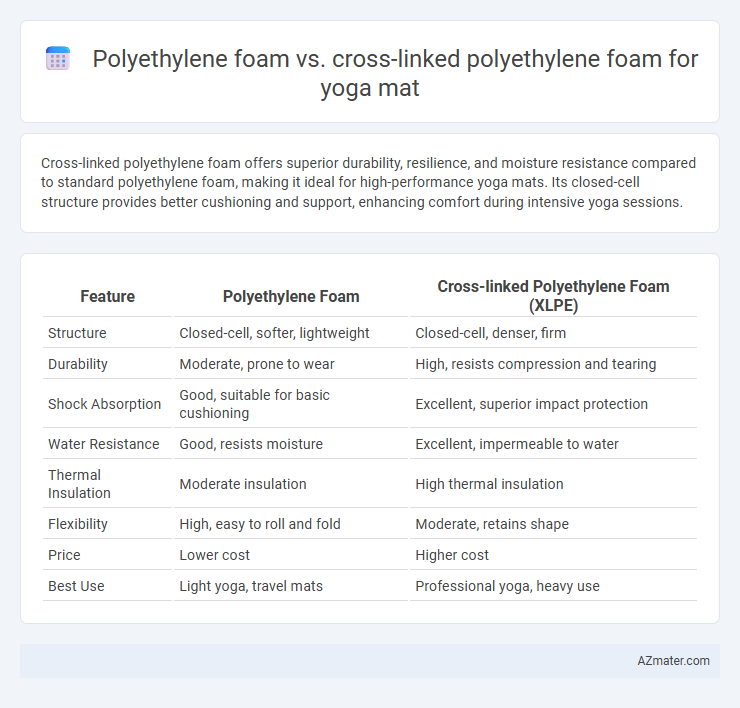Cross-linked polyethylene foam offers superior durability, resilience, and moisture resistance compared to standard polyethylene foam, making it ideal for high-performance yoga mats. Its closed-cell structure provides better cushioning and support, enhancing comfort during intensive yoga sessions.
Table of Comparison
| Feature | Polyethylene Foam | Cross-linked Polyethylene Foam (XLPE) |
|---|---|---|
| Structure | Closed-cell, softer, lightweight | Closed-cell, denser, firm |
| Durability | Moderate, prone to wear | High, resists compression and tearing |
| Shock Absorption | Good, suitable for basic cushioning | Excellent, superior impact protection |
| Water Resistance | Good, resists moisture | Excellent, impermeable to water |
| Thermal Insulation | Moderate insulation | High thermal insulation |
| Flexibility | High, easy to roll and fold | Moderate, retains shape |
| Price | Lower cost | Higher cost |
| Best Use | Light yoga, travel mats | Professional yoga, heavy use |
Introduction to Yoga Mat Materials
Polyethylene foam offers lightweight cushioning and excellent shock absorption, making it a popular choice for entry-level yoga mats. Cross-linked polyethylene foam provides superior durability, enhanced density, and better resistance to compression, suitable for practitioners seeking long-lasting support and stability. Both materials differ in texture and resilience, impacting grip, comfort, and overall performance during yoga sessions.
What is Polyethylene Foam?
Polyethylene foam is a closed-cell foam known for its lightweight, durability, and excellent cushioning properties, making it a popular choice for yoga mats that require comfort and impact absorption. Cross-linked polyethylene foam, a subtype created through a chemical process that enhances its density and resilience, offers superior support and longevity compared to standard polyethylene foam. Both materials provide good moisture resistance and insulation, but cross-linked polyethylene foam typically delivers enhanced durability and comfort for prolonged yoga practice.
What is Cross-linked Polyethylene Foam?
Cross-linked polyethylene foam (XLPE) is a high-density, closed-cell foam known for its durability, excellent shock absorption, and resistance to water and chemicals, making it ideal for yoga mats. Unlike standard polyethylene foam, XLPE undergoes a chemical cross-linking process that enhances its structural integrity and provides superior cushioning and support. This makes cross-linked polyethylene foam yoga mats more resilient and long-lasting, especially suitable for intense practice and outdoor use.
Structural Differences Between Polyethylene and Cross-linked PE Foam
Polyethylene foam is produced through a physical or chemical blowing process creating a soft, open-cell structure that offers moderate cushioning and flexibility. Cross-linked polyethylene foam, however, undergoes a cross-linking process that transforms the polymer chains into a three-dimensional network resulting in closed-cell structure, enhanced durability, and improved resistance to compression and moisture. These structural differences make cross-linked PE foam denser, more resilient, and better suited for high-impact yoga practices compared to the softer, more compressible standard polyethylene foam.
Cushioning and Comfort Comparison
Polyethylene foam offers lightweight cushioning with moderate softness, ideal for yoga mats requiring balance between support and pliability. Cross-linked polyethylene foam provides superior durability and higher resilience, resulting in enhanced comfort by maintaining shape and reducing impact over extended use. The denser structure of cross-linked foam absorbs shock more effectively, making it preferable for practitioners seeking long-lasting comfort and joint protection during workouts.
Durability and Longevity
Cross-linked polyethylene foam exhibits superior durability compared to standard polyethylene foam due to its enhanced molecular structure, which provides increased resistance to compression, wear, and tear over time. This type of foam maintains its cushioning and shape better, ensuring a longer lifespan for yoga mats subjected to frequent use. Polyethylene foam may offer initial comfort but tends to degrade faster under regular pressure and stretching, making cross-linked polyethylene foam the preferred choice for longevity in yoga mats.
Water Resistance and Moisture Management
Polyethylene foam offers excellent water resistance due to its closed-cell structure, preventing water absorption and making it ideal for wet or sweaty yoga sessions. Cross-linked polyethylene (XLPE) foam also provides superior moisture management by resisting water penetration and drying quickly, enhancing hygiene and durability. Both materials ensure minimal moisture retention, but XLPE foam typically exhibits better resilience and long-term performance in damp environments.
Eco-Friendliness and Safety
Cross-linked polyethylene foam (XLPE) offers superior eco-friendliness for yoga mats due to its closed-cell structure, which resists water absorption and reduces microbial growth, enhancing durability without harmful chemical additives. Polyethylene foam (PE) is lightweight but may contain more volatile organic compounds (VOCs) that impact indoor air quality and environmental safety during manufacturing and disposal. Choosing XLPE foam prioritizes safety with hypoallergenic and non-toxic properties, making it a better sustainable option for eco-conscious yoga practitioners.
Price and Value for Money
Polyethylene foam yoga mats generally offer lower prices due to their simpler manufacturing process, making them an affordable option for beginners or casual users. Cross-linked polyethylene foam mats provide superior durability, resilience, and support, which often justifies their higher price with better long-term value and enhanced comfort during practice. Evaluating factors such as density, cushioning, and lifespan is essential to determine the best value for money based on individual yoga needs and frequency of use.
Which Foam is Best for Your Yoga Practice?
Cross-linked polyethylene foam offers superior resilience, denser cushioning, and excellent moisture resistance, making it ideal for intense yoga sessions requiring strong support and durability. Polyethylene foam provides a softer, lightweight option with good shock absorption but may compress faster under frequent use. For a balanced mix of comfort, durability, and moisture control in your yoga mat, cross-linked polyethylene foam is generally the best choice for consistent practice.

Infographic: Polyethylene foam vs Cross-linked polyethylene foam for Yoga mat
 azmater.com
azmater.com